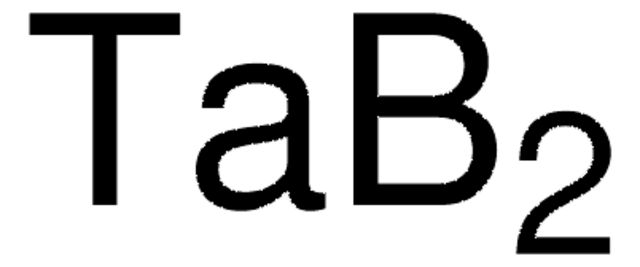336289
Titanium boride
powder, <10 μm
Se connecterpour consulter vos tarifs contractuels et ceux de votre entreprise/organisme
About This Item
Formule linéaire :
TiB2
Numéro CAS:
Poids moléculaire :
69.49
Numéro CE :
Numéro MDL:
Code UNSPSC :
12352300
ID de substance PubChem :
Nomenclature NACRES :
NA.23
Produits recommandés
Forme
powder
Taille des particules
<10 μm
Densité
4.52 g/mL at 25 °C (lit.)
Chaîne SMILES
B#[Ti]#B
InChI
1S/2B.Ti
Clé InChI
QYEXBYZXHDUPRC-UHFFFAOYSA-N
Catégories apparentées
Application
- Surface Modifications to Reduce Wear in Hot Extrusion of Copper: Discusses the use of titanium boride in surface treatments to enhance the wear resistance of tools used in the hot extrusion of copper (Thewes et al., 2024).
- Stable DC Vacuum Arc Plasma Generation from a 100 mm TiB2 Cathode: Explores the use of titanium boride in generating stable plasma for coatings, emphasizing its efficiency and stability in industrial applications (Zhirkov et al., 2024).
- Structure Searches and Superconductor Discovery in XB2: Investigates various titanium boride compounds in the context of their structural properties and potential superconductivity applications (Meng et al., 2024).
Mention d'avertissement
Warning
Mentions de danger
Conseils de prudence
Classification des risques
Acute Tox. 4 Oral
Code de la classe de stockage
11 - Combustible Solids
Classe de danger pour l'eau (WGK)
WGK 3
Point d'éclair (°F)
Not applicable
Point d'éclair (°C)
Not applicable
Équipement de protection individuelle
dust mask type N95 (US), Eyeshields, Gloves
Faites votre choix parmi les versions les plus récentes :
Déjà en possession de ce produit ?
Retrouvez la documentation relative aux produits que vous avez récemment achetés dans la Bibliothèque de documents.
Les clients ont également consulté
Changchun Cao et al.
Huan jing ke xue= Huanjing kexue, 23(6), 108-110 (2003-03-07)
Using 365 nm and 254 nm UV lamp as light source, the degradation of dye X-3B in photolysis, photocatalysis and electrical enhanced photocatalysis was studied in this research. The result shows that the degradation rate of photocatalysis of X-3B was
Yarui An et al.
Chemistry (Weinheim an der Bergstrasse, Germany), 16(48), 14439-14446 (2010-11-03)
α-Synuclein (α-SYN) is a very important neuronal protein that is associated with Parkinson's disease. In this paper, we utilized Au-doped TiO(2) nanotube arrays to design a photoelectrochemical immunosensor for the detection of α-SYN. The highly ordered TiO(2) nanotubes were fabricated
I Dion et al.
Biomaterials, 14(2), 107-110 (1993-01-01)
Ceramics are more and more frequently under consideration for construction of blood-contacting devices, i.e. cardiac valves or cardiac assist devices. This study evaluated the haemolysis eventually initiated in vitro by ceramic powders (Al2O3, ZrO2/Y2O3, AlN, B4C, BN, SiC, Si3 N4
Marta Pegueroles et al.
Biointerphases, 7(1-4), 48-48 (2012-08-10)
An understanding of protein adsorption process is crucial for designing biomaterial surfaces. In this work, with the use of a quartz-crystal microbalance with dissipation monitoring, we researched the following: (a) the kinetics of adsorption on TiO(2) surfaces of three extensively
Pengyu Dong et al.
Nanoscale, 4(15), 4641-4649 (2012-06-22)
Graphene sheets were obtained through solvothermal reduction of colloidal dispersion of graphene oxide in benzyl alcohol. The graphene/rod-shaped TiO(2) nanocomposite was synthesized by this novel and facile solvothermal method. During the solvothermal reaction, both the reduction of graphene oxide and
Notre équipe de scientifiques dispose d'une expérience dans tous les secteurs de la recherche, notamment en sciences de la vie, science des matériaux, synthèse chimique, chromatographie, analyse et dans de nombreux autres domaines..
Contacter notre Service technique










